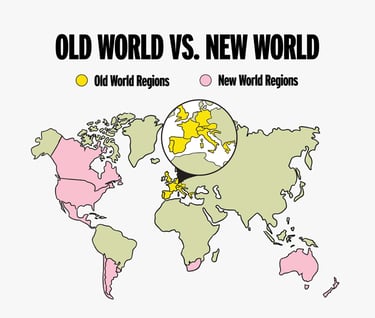
Subscribe to our newsletter
Old World vs. New World Wines
A Cultural Exploration
6/13/20242 min read


Introduction
The distinction between Old World and New World wines is fundamental in the wine community, reflecting not only geographical differences but also diverse winemaking philosophies, traditions, and market perceptions. This week, we delve into the contrasts and contributions of each, exploring how these differences can influence investment strategies and wine appreciation.
1. Defining Old World and New World Wines
Old World Wines: Typically from countries with long histories of wine production such as France, Italy, Spain, and Germany. These wines are often defined by their emphasis on balance, tradition, and adherence to strict regional regulations.
New World Wines: Originating from countries like the USA, Australia, South Africa, and Argentina, these wines are characterized by innovative winemaking techniques, more pronounced fruit flavors, and often higher alcohol content. They are usually crafted with fewer restrictions, allowing for greater experimentation.
2. Characteristics and Winemaking Styles
Terroir vs. Fruit: Old World wines generally express the terroir of where the grapes are grown, with more subtle flavors reflective of their environment. New World wines, conversely, often showcase the fruit itself, with bolder, more intense flavors.
Winemaking Techniques: Old World wineries typically follow a more traditional approach, heavily regulated by regional wine laws that dictate everything from grape varieties to winemaking practices. New World regions tend to embrace modern techniques and technology, pushing the boundaries of viticulture and vinification.
3. The Influence on Wine Investment
Market Perception: Old World wines are often perceived as more prestigious investments, particularly classics such as Bordeaux, Burgundy, and Tuscan wines. New World wines, while sometimes seen as less traditional, offer burgeoning opportunities for growth due to increasing recognition and quality improvements.
Investment Potential: New World regions are attracting investors with innovative practices and climatic advantages that allow for consistent high-quality production, potentially yielding quicker returns. Old World wines, while typically requiring a longer maturation period, often hold greater long-term value appreciation and historical prestige.
4. Exploring Key Regions and Their Wines
Iconic Old World Regions: Bordeaux (France), Tuscany (Italy), Rioja (Spain), and Mosel (Germany) are highlighted for their storied histories and classic wines.
Prominent New World Challengers: Napa Valley (USA), Barossa Valley (Australia), Central Otago (New Zealand), and Mendoza (Argentina) represent the dynamic and innovative spirit of New World winemaking.
5. Practical Tips for Investors
Diversification: Including both Old World and New World wines in your portfolio can balance risk and provide a broad exposure to the global wine market.
Cultural Insight: Understanding the cultural, regulatory, and climatic contexts of the regions can aid in making informed decisions that align with market trends and consumer preferences.
Conclusion
The comparison between Old World and New World wines offers more than just an academic distinction—it reveals a spectrum of investment opportunities and sensory experiences. Recognizing the strengths and potentials of each can significantly enhance both the sophistication and diversity of your wine portfolio.
Expand your wine horizons by exploring the unique characteristics and investment opportunities presented by Old World and New World wines. Subscribe to our newsletter for in-depth analyses, featured regions, and expert insights into the evolving wine landscape.
